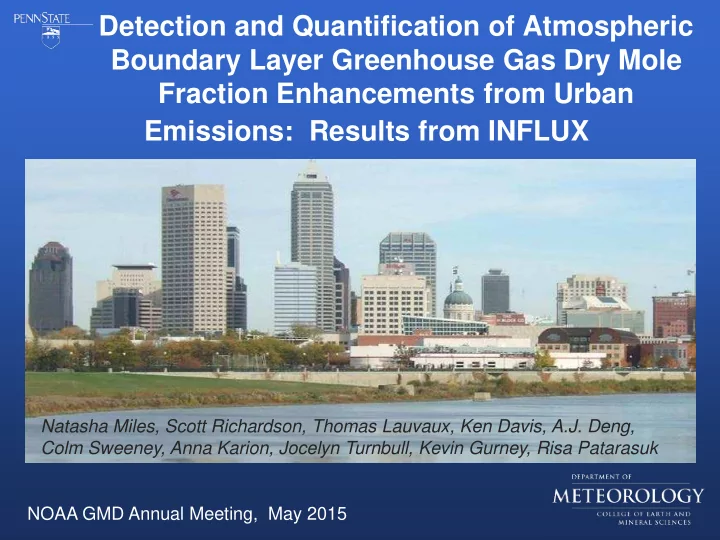

Detection and Quantification of Atmospheric Boundary Layer Greenhouse Gas Dry Mole Fraction Enhancements from Urban Emissions: Results from INFLUX Natasha Miles, Scott Richardson, Thomas Lauvaux, Ken Davis, A.J. Deng, Colm Sweeney, Anna Karion, Jocelyn Turnbull, Kevin Gurney, Risa Patarasuk NOAA GMD Annual Meeting, May 2015
Goals of the Indianapolis Flux Experiment (INFLUX) • Develop and assess methods of quantifying greenhouse gas emissions at the urban scale , using Indianapolis as a test bed. • In particular: – Determine whole-city emissions of CO 2 and CH 4 (P-17 Alexie Heimburger) – Calculate emissions of CO 2 (and CH 4 ) at 1 km 2 spatial resolution and ~weekly temporal resolution across the city – Distinguish biogenic vs. anthropogenic sources of CO 2 (P-14 Kai Wu) – Quantify and reduce uncertainty in urban emissions estimates
INFLUX: Urban scale emissions • Compare to “Bottom-up” inventories which use economic data and emissions factors • Atmospheric methods have the potential to provide independent emissions estimates • “Urban box model” 1. Measure GHG concentrations upwind and downwind of a source 2. Model atmospheric transport (backward) 3. Optimize emissions by minimizing the difference between modeled and observed GHG concentrations Mean horizontal wind CO2, CO, CH4 Upwind site Downwind site
INFLUX Measurement Network • Picarro sensors on communications towers 39-136 m AGL • 12 measuring CO2, 10 with CH4, and 5 with CO • NOAA automated flask samplers • NOAA Doppler LIDAR • Eddy flux at 4 towers • Flights (~monthly) with CO2, CH4, and flask sampler • TCCON-FTS for 4 months (Sept-Dec 2012)
Evaluation of potential background sites: INFLUX in-situ CO 2 observations “perfect” 05 09 city Wind 1 Jan – 30 Apr 2013 Afternoon hours 04 01 • Enhancement: defined as difference between each potential background site and the INFLUX minimum for that hour • Site 01 is the best overall background site • Also Site 09 (when the wind is from the SE)
Evaluation of potential background sites: INFLUX in-situ CO 2 observations 1 4 05 09 city 1 Jan – 30 Apr 2013 Afternoon hours 04 01 • Enhancement: defined as difference between each potential background site and the INFLUX minimum for that hour • Site 01 is the best overall background site • Also Site 09 (when the wind is from the NW/SE)
Spatial structure of urban CH 4 : observed • Observed CH 4 : afternoon values, averaged Oct – Dec 2013 • Ranges from 5 ppb at Site 13 (10 km east of the city) to 21 ppb at Site 10 (near the landfill). Landfill • Miles et al., in prep
Spatial structure of urban CO: observed • Observed CO: afternoon values, averaged Jan-April 2013 • Ranges from 6 ppb at Site 09 (24 km downwind of the edge of the city), to 29 ppb at Site 03 (downtown). • Miles et al., in prep
Spatial structure of urban CO 2 : observed • Observed CO 2 : afternoon values, averaged Jan-April 2013 • Site 09: 0.3 ppm larger than Site 01 • Site 03: larger [CO 2 ] by 3 ppm • Miles et al., in prep
High resolution inverse modeling - Weather Research and Forecasting model (WRF) : 9km/3km/1km (nested) - Four Dimensional Data Assimilation (FDDA) - Coupled to backward Lagrangian model (Uliasz et al., 1994) - Kalman matrix inversion using Hestia 2013 emissions as a priori Lauvaux et al., in prep
INFLUX: Urban scale inversion 50 100 150 200 Inverse emissions (ktC): Case: Background = Site 1 hourly Sept 2012 to April 2013 Total Hestia : 4750 ktC Total Posterior : 5231 ktC 5-day emissions (ktC) Date • Errors are significantly reduced after inversion, from 25% to 9% on average • Posterior emissions higher Sept to mid Nov • Total posterior emissions are 10% higher than Hestia Lauvaux et al., in prep
Inverse emission estimates using different inverse system configurations and prior emissions ODIAC Inverse emissions (MtC): Hestia (prior emissions) Sept 2012 – April 2013 4 Sites (B) 4 Sites (A) 4 Sites (L=4km) 4 Sites (L=4km) Low Traffic Low Utility Hourly Transport Error 10-day window 20-23 UTC Daily Min Wind Model Post ODIAC Large σ B 2 Initial L=12km configuration L=4km L=0km 4.0 4.5 5.0 5.5 6.0 6.5 Lauvaux et al., in prep
Conclusions • Tower observations detect a clear urban signal in CO2/CH4/CO (buried amid lots of synoptic “ noise ” ). • Average afternoon dormant-season enhancements are as high as • 21 ppb CH4 • 28 ppb CO • 3.0 ppm CO2 • The inverse emissions and Hestia are within 10% for the period Sept 2012 - April 2013. 16 different configurations with very different assumptions yield similar results. Influx.psu.edu
Recommend
More recommend